Using brick on your new construction build offers best durability, energy efficiency, and lasting value that can benefit your facility for decades. While the upfront investment is a little higher than other materials, brick's exceptional longevity and low maintenance requirements make it a smart choice for commercial and institutional buildings.
Key Benefits of Using Brick on Your New Construction Build:
Brick has been among the world's oldest building materials for good reason. Modern brick construction combines this time-tested durability with advanced building techniques. Today's builders can choose from solid brick bearing walls, brick veneer systems, or thin brick applications depending on structural needs and budget considerations.
The construction industry has seen renewed interest in brick building systems, particularly as facilities managers seek materials that reduce long-term operational costs. While wood prices have fluctuated dramatically, brick offers predictable performance and minimal maintenance requirements that appeal to commercial property managers.
For California construction projects, brick provides excellent resistance to wildfires - a growing concern for many facilities. The material's non-combustible nature and ability to contain fire spread make it valuable for institutional buildings, healthcare facilities, and educational campuses.
Using brick on your new construction build brings together centuries of proven performance with modern construction techniques. When you choose brick, you're not just selecting a building material – you're investing in a comprehensive solution that delivers on multiple fronts.

Brick's natural composition makes it a standout choice for health-conscious builders. Unlike many synthetic materials, brick doesn't emit volatile organic compounds (VOCs), creating cleaner indoor air for your family. The clay and shale used in brick production are naturally abundant materials that can be recycled or reused, making them an excellent choice for sustainable construction practices. You can learn more about eco-friendly materials in our comprehensive guide.
What really sets brick apart is its remarkable ability to handle whatever nature throws at it. Weather resistance keeps your building protected through California's diverse climate conditions, from coastal fog to inland heat waves. Pest resistance means termites and other destructive insects simply can't damage your walls. Fire safety becomes a major advantage, especially in wildfire-prone areas throughout California, since brick is completely non-combustible. And if you've ever lived near a busy street, you'll appreciate brick's excellent sound insulation properties.
Here's where brick really shines – its incredible lifespan makes it one of the smartest long-term investments you can make. We're talking about structures that can last 100 to 500 years with proper maintenance. That's not just impressive; it's practically generational wealth building.
This extraordinary longevity comes from brick's ability to stand up to severe weather conditions. During storm resistance testing, brick consistently outperforms other materials when facing high winds and debris impact. A comprehensive study on brick's storm protection demonstrates just how well brick structures hold up during hurricanes and tornadoes.
The non-combustible nature of brick provides an additional layer of security that's particularly valuable in California's fire-prone regions. Even after exposure to extreme heat, brick often maintains its structural integrity and can frequently be reused, making it both resilient and sustainable.
One of brick's most valuable features is its thermal mass – the ability to absorb and store heat energy. During hot California days, brick walls soak up heat, then slowly release it as temperatures cool in the evening. This natural heat absorption and heat release cycle creates passive temperature regulation that can significantly reduce your energy bills.
This thermal performance translates into real comfort and savings. Your heating and cooling systems don't have to work as hard to maintain comfortable temperatures, leading to lower energy bills year-round. The same dense properties that provide thermal benefits also make brick an excellent sound barrier, creating quieter, more peaceful indoor spaces.
When you're considering using brick on your new construction build, it's helpful to understand that not all brick construction is created equal. The days of building entire walls from solid brick have largely given way to more flexible, cost-effective approaches that still deliver brick's timeless beauty and durability.
Modern brick construction offers three main approaches, each with its own sweet spot depending on your project's needs, budget, and structural requirements. Whether you're planning a small stand alone store or a large commercial facility, understanding these options will help you make the best choice for your specific situation. For comprehensive insights into modern construction approaches, explore our expertise in ground-up construction.

The key difference between these methods lies in whether the brick actually holds up your building or simply makes it look beautiful. This distinction affects everything from your foundation requirements to your final construction timeline.
Think of solid brick construction as the "old school" approach - and we mean that in the best possible way. This is how builders constructed those magnificent century-old buildings you see throughout San Francisco and Los Angeles that are still standing strong today.
In structural masonry, the brick walls themselves carry the weight of your building. These load-bearing walls are typically built using double-wythe or triple-wythe construction, meaning two or three layers of brick work together to support floors, roofs, and everything else above.
This traditional method creates incredibly robust structures that can last for centuries. However, it requires a much more substantial foundation to handle all that brick weight. While less common for new residential projects today, solid brick remains an excellent choice when maximum durability and fire resistance are your top priorities.
Here's where modern engineering really shines. Brick veneer has become the gold standard for new construction because it gives you all the beauty and many benefits of brick without some of the traditional challenges.
The real genius lies in the air gap - typically about an inch - between the brick and your building's framing. This cavity serves multiple important purposes. It allows any moisture that gets through the brick to drain harmlessly away through weep holes at the bottom. It also provides space for insulation, boosting your energy efficiency significantly.
This system requires careful attention to moisture management details like proper flashing and drainage, but when done correctly, it combines the best of both worlds: modern structural efficiency with classic brick durability.
Sometimes you want the brick look without the brick weight or cost. That's where thin brick veneer comes in. These units are typically less than an inch thick and get adhered directly to your existing wall system.
This aesthetic cladding option offers several practical advantages. It's significantly lighter than full brick, making it faster to install and easier on your structure. The lower material and labor costs make it an attractive option for budget-conscious projects.
You can use thin brick veneer on both interior and exterior applications, giving you lots of design flexibility. However, it's important to set realistic expectations - while it looks great, thin brick veneer doesn't offer the same level of protection against fire and pests as full-thickness brick, and it typically won't last quite as long.
For many projects, especially where you're adding brick character to an existing building or working within tight budget constraints, thin brick veneer provides an excellent balance of appearance and practicality.
While using brick on your new construction build offers incredible long-term benefits, let's be honest about the practical realities you'll face. The upfront investment is substantial, the construction process requires specialized expertise, and California's unique building requirements add another layer of complexity. Understanding these factors upfront helps you make informed decisions and plan accordingly.

The biggest sticker shock with brick construction comes from two main sources: material costs and skilled labor requirements. Brick itself costs significantly more than vinyl siding or wood alternatives, but that's just the beginning of the story.
The real cost driver is finding and hiring skilled masons. This is becoming increasingly challenging as fewer craftspeople enter this physically demanding trade. Bricklaying is an art that requires years of experience to master, and quality masons command premium wages for good reason. In fact, labor can account for roughly half the total cost of your brick construction project.
Here's where the math gets interesting though. While your initial investment is higher, brick's exceptional durability and minimal maintenance needs often make it cost-effective over the building's lifetime. You're essentially paying more upfront to save significantly on repairs, replacements, and energy costs for decades to come.
California's seismic activity creates unique challenges for using brick on your new construction build. The state's building codes are among the strictest in the nation, and for good reason - older unreinforced masonry buildings have historically performed poorly during earthquakes.
Modern brick construction in California looks completely different from historical methods. Today's engineered design incorporates steel reinforcement and advanced structural techniques that allow brick buildings to flex and move with seismic forces rather than crack and crumble. Whether you choose reinforced brick veneer or structurally engineered solid masonry, these systems are specifically designed to meet California's rigorous earthquake safety standards.
Foundation requirements also become more critical with brick construction. The additional weight demands a more robust foundation system, which adds to both cost and complexity. Our team ensures every foundation is properly engineered to handle these loads while meeting all local Los Angeles building codes and regulations.
One of brick's biggest selling points is being "low maintenance," but let's clarify what that actually means. Brick requires less frequent attention than painted surfaces, but it's not completely maintenance-free. When issues do arise, repairs can be complex and expensive.
Annual cleaning keeps your brick looking its best and helps you spot potential problems early. A simple mixture of mild detergent and water with a soft brush does the job - just avoid high-pressure washers that can damage mortar joints.
Mortar repointing represents the most significant maintenance task you'll face. Over time, weather and settling cause mortar joints to deteriorate and crumble. This isn't a DIY weekend project - repointing requires removing damaged mortar and carefully replacing it with new material that matches the original in both composition and appearance.
Moisture damage prevention requires ongoing vigilance. Keep weep holes clear of debris so water can drain properly from wall cavities. Trim vegetation away from brick walls since vining plants can work their roots into mortar joints and cause structural damage over time.
The repair complexity becomes apparent when damage occurs. Unlike replacing a section of vinyl siding, brick repairs often require removing multiple units and rebuilding entire sections. This complexity makes repairs more expensive and time-consuming, though thankfully, properly constructed brick buildings rarely need major repairs for many decades.
Despite these maintenance considerations, brick's overall upkeep requirements remain minimal compared to other exterior materials, making it an excellent choice for facilities focused on long-term operational efficiency.
When you're using brick on your new construction build, you're not just choosing durability – you're opening the door to incredible design possibilities. Gone are the days when brick meant only traditional red rectangles. Today's brick technology offers a world of creative options that can bring any architectural vision to life, whether you're building a sleek Orange County office complex or a charming educational campus in Riverside.
Modern brick manufacturing has transformed this ancient material into something truly versatile. The aesthetic options available today would surprise anyone who thinks brick is limited to classic red and brown. With hundreds of colors, textures, and finishes now available, brick can complement any architectural style while maintaining all its structural benefits.
The variety of brick options available today is honestly amazing. Manufacturers now produce brick in sophisticated grays for contemporary commercial buildings, crisp whites for modern residential projects, and even dramatic blacks for striking accent walls. Multi-toned blends create depth and visual interest that can make any building stand out.
Beyond color, texture plays a huge role in brick's visual impact. Smooth finishes create clean, modern lines perfect for institutional buildings, while rough textures add character and warmth to residential projects. Different sizes – from traditional modular brick to longer Roman brick – can dramatically change a building's proportions and feel.
The range of available finishes means you can achieve almost any look you're after. Whether you want the timeless appeal of traditional red brick or the cutting-edge style of contemporary charcoal tones, modern brick technology makes it possible. You can explore the impressive variety of modern brick color options to see just how far this material has evolved.
What's really exciting about modern brick construction is how creative surface treatments can completely transform the material's appearance while keeping all its practical benefits. These techniques let you achieve unique looks that perfectly match your project's design goals.
The German smear technique has become incredibly popular for creating that weathered, Old World charm. This involves applying a thin, irregular layer of mortar over the brickwork, creating beautiful texture while letting some original brick show through. It's perfect for projects that need character and warmth.
Limewash offers another fantastic option, especially for facilities that want a soft, traditional appearance. This breathable treatment creates a beautiful chalky finish that actually helps protect the brick underneath. It's particularly effective on educational campuses or healthcare facilities where you want a calming, timeless look.
For projects that need specific colors, brick staining is far superior to painting. Unlike paint, stain is absorbed into the brick, allowing it to breathe naturally. This prevents the moisture problems that painted brick often develops – like peeling, chipping, and trapped moisture that can lead to serious damage. Staining maintains the brick's natural characteristics while giving you the color flexibility you need.
It's worth noting that painting brick can create significant maintenance headaches. Paint traps moisture, which can cause deterioration and create ongoing maintenance issues. If your project absolutely requires a painted finish, it's better to specify special "painter's brick" that's manufactured specifically for that purpose.
One of the most exciting aspects of modern brick construction is how beautifully it combines with other materials. Brick pairs wonderfully with glass for contemporary office buildings, works beautifully with steel for industrial-style projects, and creates stunning contrasts when combined with wood elements. This flexibility means you can create truly innovative designs that take advantage of brick's strength while achieving exactly the aesthetic you're after.
These design possibilities make using brick on your new construction build an investment in both function and beauty. You get all the durability and energy efficiency benefits we've discussed, plus the ability to create something truly distinctive that will look great for decades to come.
Yes, using brick on your new construction build does come with higher upfront costs compared to other exterior materials like vinyl or wood siding. The reality is that brick is a premium material, and you're also paying for the specialized craftsmanship that goes into proper installation.
Finding skilled masons can be challenging since it's physically demanding work that requires years of training. These professionals are often in high demand, especially in California's competitive construction market. The meticulous nature of bricklaying also means your construction timeline will be longer than a typical wood-frame build.
But here's where it gets interesting - this initial investment often pays for itself over time. You'll save significantly on maintenance costs since brick doesn't need painting, coating, or frequent repairs. The energy efficiency benefits translate to lower heating and cooling bills year after year. Plus, the boost in resale value helps offset those upfront costs, making it a smart long-term financial decision for your property.
This is where brick truly shines. Brick building have an expected lifespan of well over 100 years. With proper maintenance, research from the Clay Brick Association suggests they can last an incredible 500 years or more.
To put this in perspective, most other building materials simply can't compete with this longevity. Walk through any historic California neighborhood and you'll see brick buildings that have stood strong for over a century, weathering everything from earthquakes to wildfires.
This exceptional durability means your investment in using brick on your new construction build is truly building for generations. While other materials may need replacement or major repairs within decades, your brick structure will continue performing reliably with minimal intervention.
This is an excellent question that comes up frequently in California projects. While old, unreinforced masonry buildings can be vulnerable during earthquakes, modern brick construction is an entirely different story.
Today's brick buildings in California are built to strict engineering standards that specifically address seismic concerns. When we work on projects involving using brick on your new construction build in earthquake-prone areas, we use reinforced brick veneer systems or structurally engineered solid masonry that incorporates steel reinforcement throughout the brickwork.
These modern techniques dramatically improve the structure's ability to flex and move with seismic forces rather than cracking or failing. The result is a building that meets or exceeds all local earthquake codes while still providing all the benefits of brick construction.
At RSVC, we prioritize compliance and risk management in all our projects. Our team stays current with California's evolving building codes to ensure your brick construction project delivers both safety and long-term performance.
At RSVC, we understand that choosing the right construction approach for your new facility is one of the most important decisions you'll make. Our expertise in navigating California's building codes, managing complex construction projects, and delivering customer-centric solutions ensures your brick construction project will be handled with the care and professionalism it deserves.
We're committed to helping you create not just a building, but a lasting asset that serves your needs while contributing positively to your community. Ready to explore how brick can work for your next construction project? Learn more about our construction services and let's start building your legacy together.

